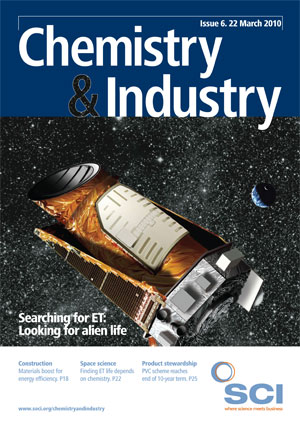China, the world’s biggest supplier of rare earth elements, is considering restricting the sale of this vital resource for green energy and electronics. Richard Corfield examines what can be done to keep global supplies flowing.
Imagine a world without mobile phones, laptop computers, LCD and plasma screens and where the move towards green energy has been permanently abandoned.
Impossible? Perhaps not. For what is not widely known is that there is only one economic supplier of rare earth elements and that supplier – the People’s Republic of China (PRC) – is shutting the door on the supply chain.
Rare earth elements (REEs) were discovered in a small quarry in the village of Ytterby in the Stockholm archipelago in the 19th century and for many years REEs were considered to be an interesting oddity buried in an obscure corner of the periodic table. But in the last two decades they have become vital for the technological and green energy revolutions. They are essential for the manufacture of mobile phones, laptops, LCD and plasma screen TVs as well as the generators in wind and wave turbines and the motors and batteries in hybrid cars.
Addicted to rare earth elements
John Mair, special projects manager of Greenland Mining and Energy, says: ‘In the last couple of years, the Western world suddenly realised that it is largely addicted to rare earth elements, and that China, the world’s overwhelmingly dominant supplier, is limiting rare earth exports to prioritise its own domestic requirements. This has resulted in an unusual situation of significant long term demand increase coinciding with a radical change in market dynamics to create a large void in the global rare earth element supply.’
What is it that makes the REEs so special? The most important feature is that through a quirk of their chemistry they make the world’s strongest permanent magnets. REEs have very high magnetic anisotropy – they easily align themselves to a magnetic field. This is because REEs have incompletely filled f-shells, which allows their electrons to retain their magnetic moments much more strongly than electrons in more completely filled orbitals. Consequently, REE magnets are more powerful than conventional ferrite (iron oxide) or alnico (aluminium-nickelcobalt) magnets, which means that smaller magnets can deliver the same magnetic force. Although REEs have low Curie temperatures – the temperature at which they lose their magnetism – when alloyed with transition metals, such as iron, nickel or cobalt, the Curie temperature of the alloy increases, which makes REE magnets suitable for a variety of everyday applications where small magnets are an advantage. Rare earth magnets routinely deliver forces of greater than 1.4 Tesla while the most powerful conventional magnets struggle to produce 1 Tesla. The stronger magnets made possible using REEs means that electric motors that use them can be smaller. This is why they are so widely used in hybrid cars, such as the Toyota Prius. In addition, the superior torque of REE magnets means that the power output from generators, such as wind turbines, is considerably enhanced.
Another consequence of the power of REE magnets is that they permit the miniaturisation of hard disk drives. Neodymium and dysprosium are the REEs with the most extreme magnetic properties and are essential for such devices. Lanthanum is the most commonly used REE in rechargeable batteries, one of the best being the nickel-metal hydride (NiMH) battery used in hybrid cars.
Mair summarises the situation succinctly: ‘Many people are surprised to realise that cell phones, laptop computers, hybrid cars, flat screen display panels, energy efficient lights and wind turbines, amongst many other items, rely on rare earth elements. But once people recognise that many rare earth applications are now commonplace in today’s society, they quickly understand why rare earths are suddenly making the headlines.’
REEs are also used in catalytic converters. With tighter vehicle emission laws being introduced throughout the world, by the end of 2010 it is predicted that 95% of all cars manufactured will have REE-based catalytic converters.
Paradoxically, REEs are not particularly rare in the Earth’s crust. Jack Lifton, author of the influential Lifton Report notes, ‘In 1400BC, iron was a rare and precious metal; in 1865AD, aluminium was a rare and precious metal and until 1945 uranium was a rare and almost useless metal.’ But in the last few months the shortage of rare earths has been making headlines. How can this be? The problem lies in the fact that 97% of the world’s supply of rare earth’s comes from China. Nearly all of it comes from a single mine near the city of Baotou in Inner Mongolia, while the remainder comes from small and sometimes illegal mines situated on the ionic clays in the south of the country where pollution from the poisonous and sometimes radioactive ores now poses a serious environmental problem. In October 2009, a report by China’s Ministry of Industry and Information Technology revealed that the PRC may be planning to completely ban the export of up to five rare earths and restrict the supply of the remaining metals. In particular there are rumours that the supply of at least two of the so called ‘heavy’ REEs – terbium and dysprosium – could be stopped as early as next year. This gels with Mair’s prediction that the first REE shortages will occur among the scarce heavy rare earths.
Rare earths

And the problem will get worse because of China’s own rapidly expanding economy. ‘I believe that Chinese production and refining of rare earth metals cannot keep up with domestic demand for much longer,’ Lifton says.
What does this mean for the West? Ian London of Avalon Rare Metals points out that the US is waking up to the fact that something must be done. The US Magnet Manufacturers Association recently sent a letter to the Obama administration outlining a six point plan to address specific deficiencies in the US domestic rare earth supply. These include improving elements of the mining, refining, alloying and manufacturing supply chain. Part of the urgency for the US is that many modern smart weapons and weapons systems require REEs.
In Europe, an expert panel set up by the European Commission has put REEs on a new list of potentially critical raw materials. In the absence of EU-based mines they propose to lower REE consumption by increasing resource efficiency and recycling. However, Mair is sceptical. ‘Recycling won’t keep up with demand,’ he says. ‘The problem is that rare earths are used in very small quantities and that restricts our ability to economically recycle them.’
It is for this reason that Greenland Mining and Energy is investing in an obscure, desolate plateau in the far southwest of Greenland. Here, among the rocks of the Ilimaussaq Intrusion, are the world’s largest known reserves of REEs. Surveys have already shown that the quantity of REEs there would meet at least a quarter of global demand for the next 50 years. Mair is bullish about the company’s business model. ‘We will be using a multi-commodity scenario,’ he says, ‘where we will be mining other valuable minerals in addition to rare earths – in this case uranium, which we can forward sell – to offset the extraction costs.’ It is perhaps curious to see an Australian mining company opening up on the other side of the world, but he points out that the attraction of the Kvanefjeld Rare Earths project is too great. ‘Greenland is just opening up, it is highly prospective, well mapped in geological terms, with excellent public domain data. As a prospector it’s a fantastic place to go. It’s just been off the radar until now.’
There is little doubt that the Kvanefjeld project could make Greenland’s fortune – and at the same time remove China’s hands from the world’s technological windpipe.
Richard Corfield is a science writer based in Oxford.





